Getting your snowmobile’s track adjusted correctly doesn’t have to be complicated. In this guide, we’ll show you the tools, step-by-step instructions, and troubleshooting tips for all major brands — Polaris, Ski‑Doo/Lynx, Arctic Cat, Yamaha, and more. If you do it right, your snowmobile will run great quickly. Why Track Tension Matters Track tension directly affects […]
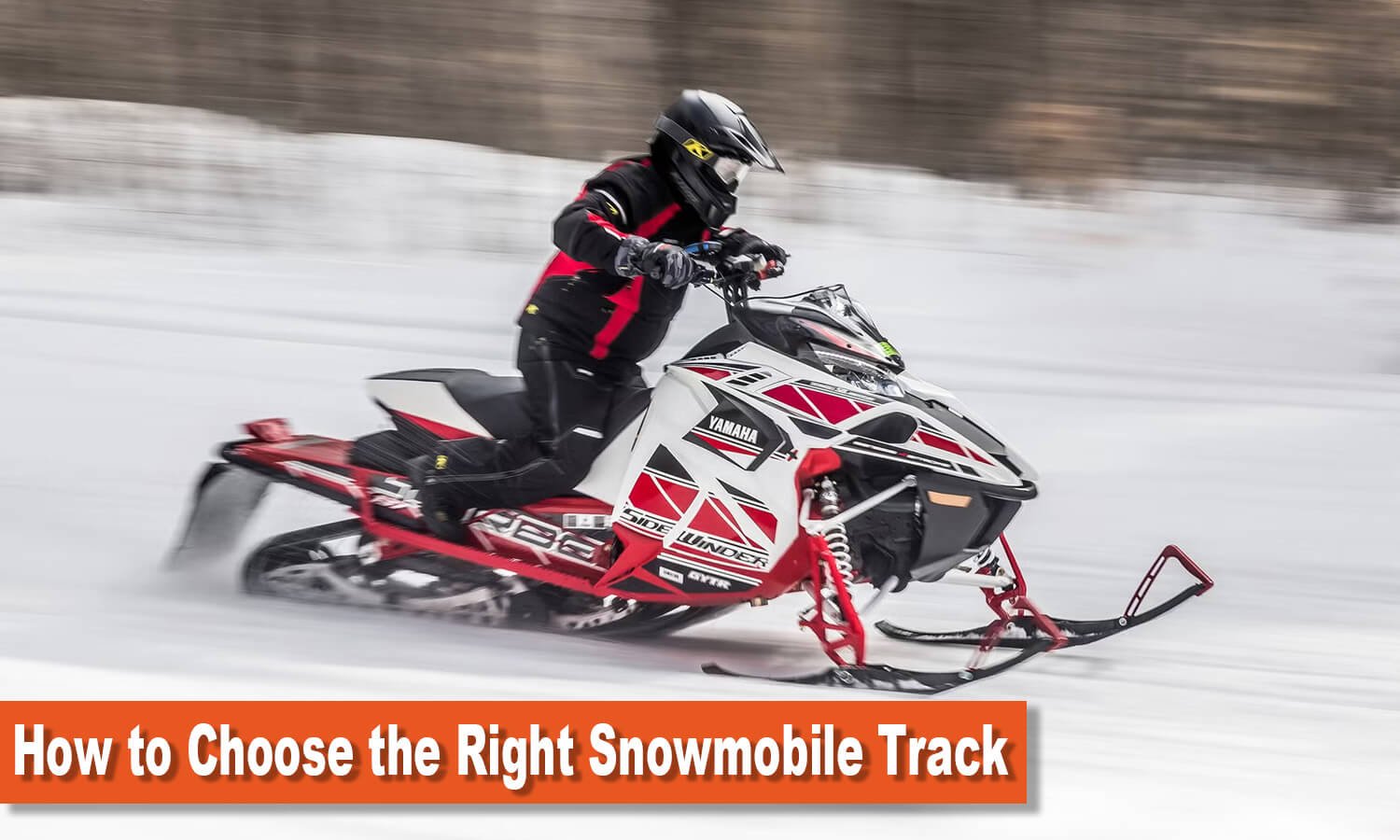
How to Choose the Right Snowmobile Track
Your snowmobile’s track is what connects you to the snow — it affects everything from traction and handling to fuel efficiency. The right track makes your sled feel smooth and responsive, while the wrong one can make it sluggish or even unsafe. This quick guide on how to choose the right snowmobile track covers the basics of track design, the main types, and how to match the best one to your riding style.
Table of Contents
Snowmobile Track Basics
Snowmobile tracks are described by several key dimensions. Understanding these terms will help you compare tracks and ensure compatibility with your sled:
Track Length
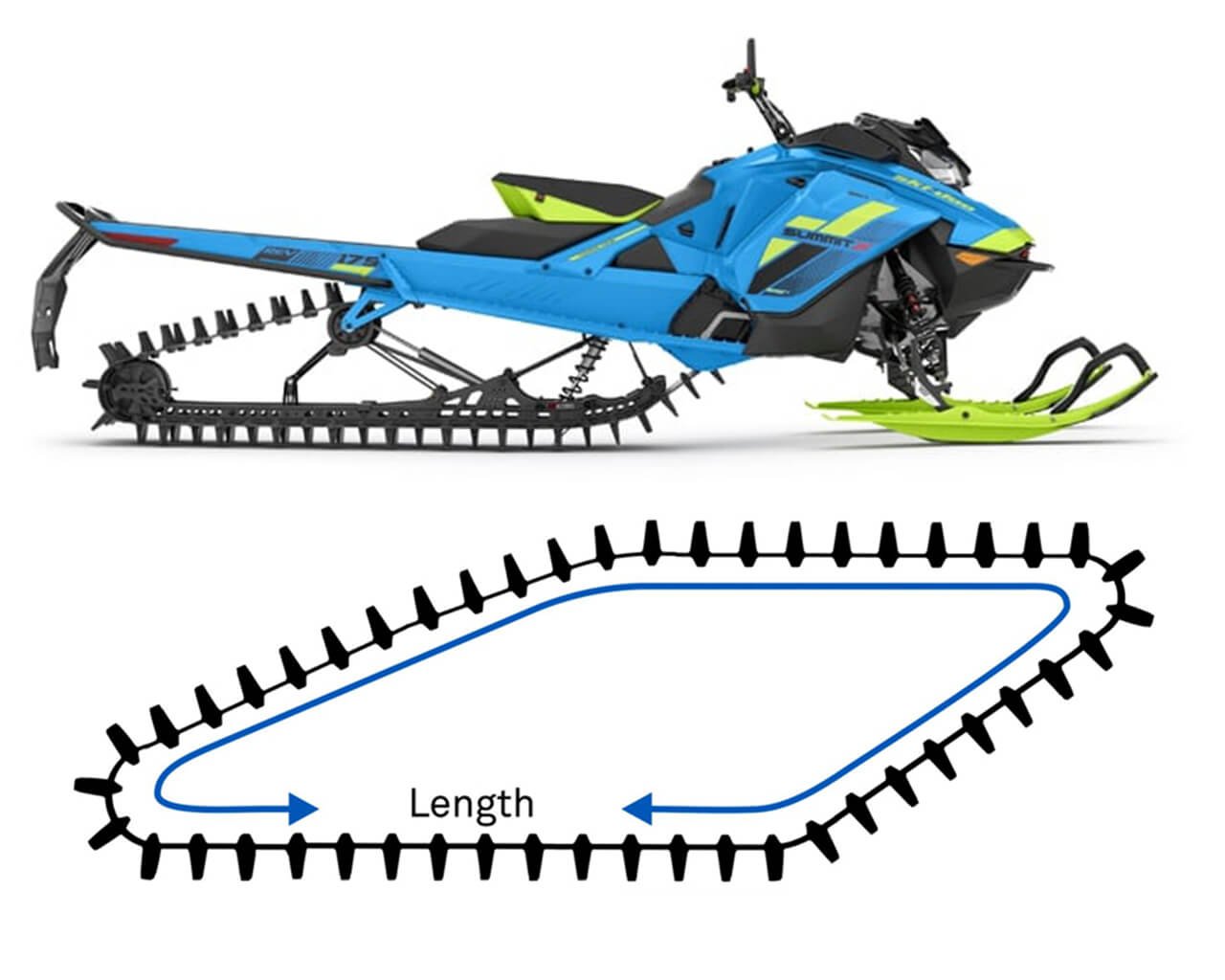
snowmobile track length
This is the internal circumference of the track, usually given in inches.
Calculation: drive pitch × number of track segments.
Shorter tracks (lower length) are generally more maneuverable and give quicker handling and stability, while longer tracks improve ride quality and “floatation” in deep snow.
For example, many trail sleds use lengths around 120–137″, whereas mountain and utility sleds often use much longer tracks (150–175″) for better flotation off-trail.
When replacing a track, the length must match your sled’s frame or be within a tolerable range (you can go slightly shorter if needed, but not longer without modifications).
Track Width
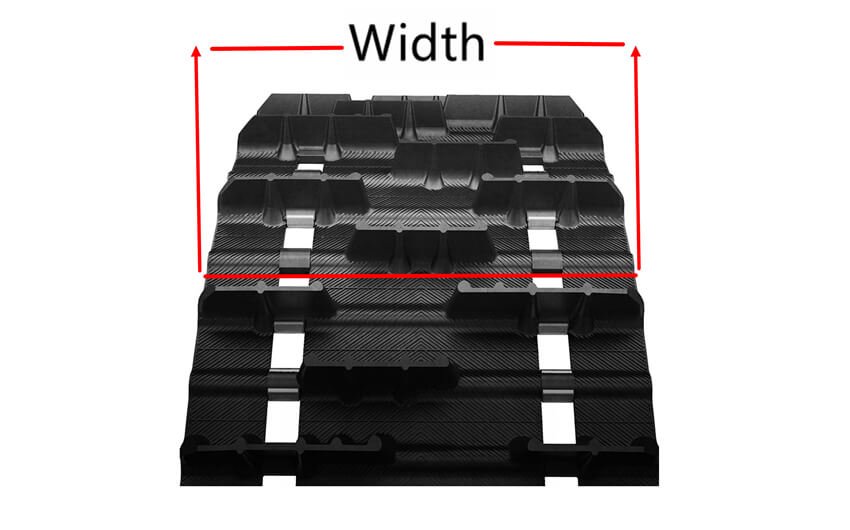
snowmobile track width
This is the width of the track (measured in inches) and is limited by the tunnel width of the snowmobile.
Common widths are 15″ and 16″ for most sleds. A slightly narrower track can sometimes be fitted (for example, a 15″ track in a 16″ tunnel) to save weight.
Narrow tracks reduce weight and improve acceleration and top speed, whereas wider tracks provide better flotation in soft, deep snow.
Tip: Make sure the track width doesn’t exceed your sled’s tunnel clearance — a track that’s too wide simply won’t fit.
Lug (Tread) Height
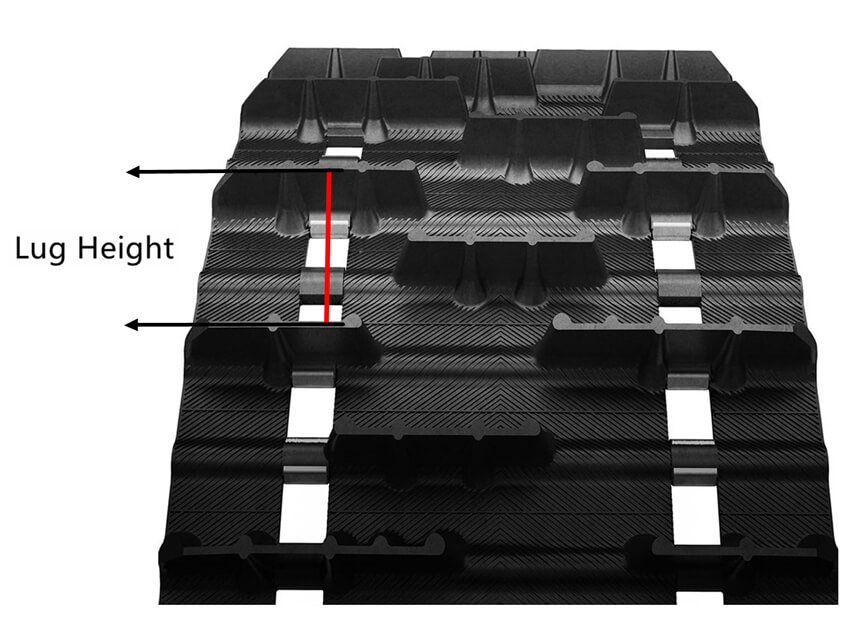
snowmobile lug height
This is the height of the lugs (the raised tread blocks) on the track, usually given in inches (e.g., 1.25″, 2.0″).
Taller lugs dig deeper into snow, greatly increasing traction. In fact, as one manufacturer notes, “more lug height equals better traction—as little as a quarter inch of extra height can make a substantial difference in acceleration and braking”.
However, taller lugs also mean more drag and weight, so there’s a trade-off. Long lugs can slow acceleration on hardpack trails and may wear faster if used on groomed snow.
Also, make sure very tall lug clear your sled’s skid rails and heat exchangers — if they hit any part of the chassis, you’ll end up with damage. The taller the lug height, the more you need to check that it actually clears your heat exchanger.
In practice, trail-only riders often use 1.25–1.5″ lugs, while deep-snow riders use 1.75″ or taller.
Drive Pitch
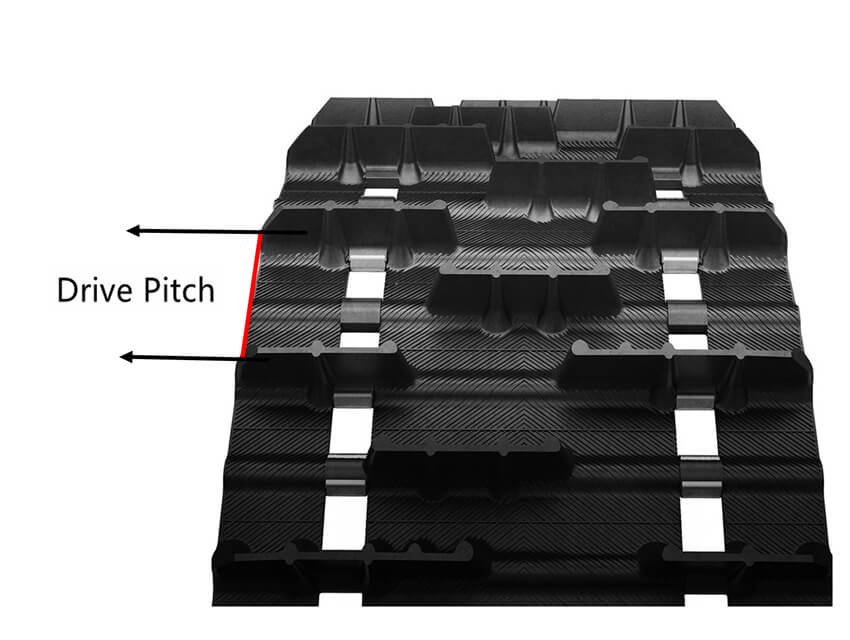
snowmobile drive pitch
Pitch is the distance between the centers of adjacent drive sprocket teeth (or track crossbars). It determines the spacing of the lugs along the track. Common pitches are 2.52″, 2.86″, and 3.0″, while newer mountain sleds sometimes use 3.5″.
The track pitch must match your snowmobile’s drive sprockets, or you’ll need to change the sprockets to fit the track.
“Drive pitch” refers to the drive cog center distance around the circumference — it must match the existing track, or the drive cogs have to be replaced.
In general, a wider pitch (e.g., 2.86″ vs 2.52″) means fewer but larger and lighter lug segments and slightly more flex in the track.
Snowmobile Track Quick Summary
Length: Shorter = quicker handling; Longer = better flotation.
Width: Narrower = faster; Wider = more floatation.
Lug Height: Higher = more traction; Lower = faster on hardpack.
Drive Pitch: Must match sled; Common: 2.52″ / 2.86″ / 3.0″.
For example, a track labeled “136x15x1.75 (2.86)” would be 136″ long, 15″ wide, with 1.75″ lug height, and a 2.86″ drive pitch.
💡 Understanding these specs helps you compare tracks easily.
Track Types: Trail, Mountain, Crossover, and Utility
Snowmobile tracks are often categorized by intended use. Each type has design features optimized for certain conditions. Here’s an overview of the main track types:
Trail Tracks
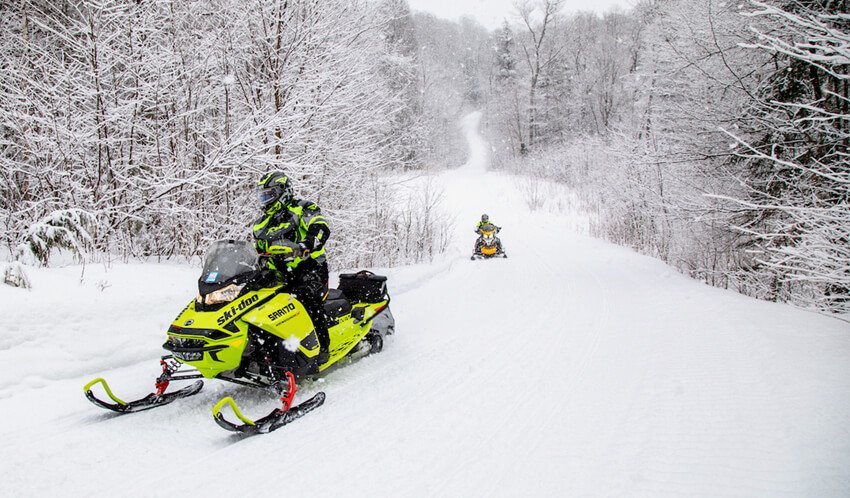
trail snowmobile track riding
Trail tracks are designed for groomed or hard-packed trails. They prioritize speed, handling, and efficiency over deep-snow flotation. Typical trail track features include:
- Length: Short to medium (often 120–137″). For example, many modern trail sleds use 129–137″. Shorter length allows quick turns and stability on hardpack. (Some trail riders upgrade to 146″ for occasional off-trail use, but standard is ~137″.)
- Width: Usually 15″ (rarely 16″). Most trail sleds have a 15″ tunnel, so trail tracks are commonly 15″ wide.
- Lug Height: Low to moderate (around 1.25″ to 1.50″). Trail riders do not need very tall lugs. In fact, Camso notes that for 100% trail riding, 1.25″–1.50″ lugs “will do the trick” and use less fuel. Shorter lugs also “give less push in corners,” improving handling. Taller lugs on groomed trails just create drag and wear.
- Drive Pitch: Often 2.86″, especially on modern sleds. This pitch balances weight and durability for trail conditions.
- Support Columns: Minimal. Trail sleds typically use fewer track support bars (columns) because the track profile can be lower for speed.
- Clip Pattern: Fully clipped. Trail tracks usually have a “fully clipped” tread pattern (lugs on every crossbar) for smooth, even traction on hard surfaces.
- Additional Features: Trail riders may add ice studs or use pre-studded tracks (e.g. Camso “Ice Storm” or “Ice Attak” models) for slick conditions. But in general, trail tracks focus on low drag and longevity.
In summary, a trail track is relatively short and narrow (around 130×15) with low lugs (1.25–1.5″). It excels on groomed terrain, offering quick handling, good top speed, and less fuel consumption. Manufacturers often call these trail or crossover (on-trail) tracks.
Mountain Tracks
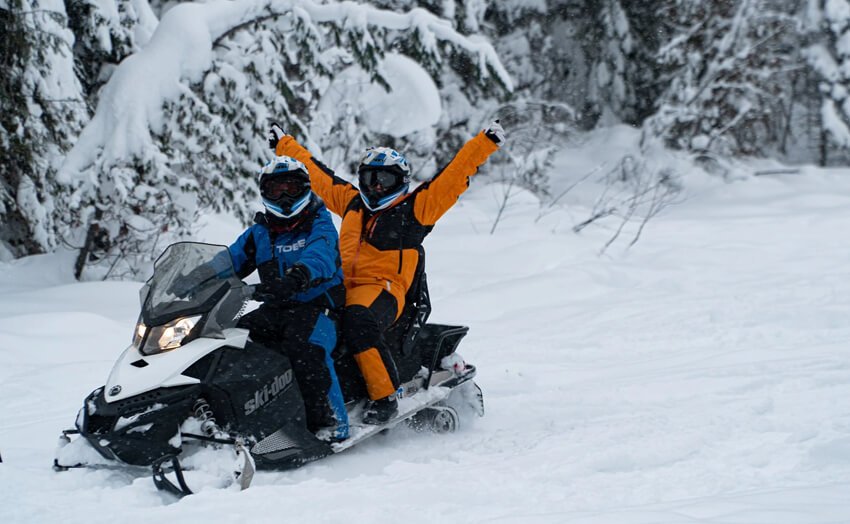
mountain snowmobile track riding
Mountain tracks (also called deep-snow or backcountry tracks) are built for soft, unpacked snow and steep terrain. They are longer and have aggressive lugs to maximize floatation and grip:
- Length: Long (often 154–175″). For deep powder and big climbs, longer tracks push the sled up instead of plowing down. For example, Camso recommends 162–175″ for general mountain riding in deep snow. (Some extreme models go as high as 177″, 180″ or more.)
- Width: Often 15″ or 16″. Wider tracks give more surface area for floatation, but many mountain riders still use 15″ due to sled design. Some utility or mountain sleds may use 16″ for extra float.
- Lug Height: Tall (roughly 2.0″ to 3.2″). Mountain tracks have the tallest lugs available. For general deep-snow riding (“boondocking”), lugs around 2.0″–2.5″ are common (e.g. 1.6″ to 2.5″ widths that are sometimes called “mountain tracks”). For climbing steep chutes or very steep terrain, extra-tall lugs (2.8″–3.2″, often cup-shaped or saw-tooth) are used. These enormous lugs bite through powder and hardpack to pull the sled up.
- Drive Pitch: Some mountain sleds use wider pitches (2.86″ or 3.0″) to reduce weight and improve flex. Camso suggests 2.6″–3.0″ for mountain riding.
- Support Columns: Many. Long, tall-lug tracks need additional support bars inside the track to keep the profile stiff and prevent lugs from folding over under load.
- Clip Pattern: Often fully clipped too, but some deep-snow tracks use every-other (open) lugs to save weight. (Studs are less common, since studs can be ripped out in soft snow.)
In summary, a mountain track is very long (often >162″) with very tall, aggressive lugs (up to 3.0″+) and robust support structure. It gives maximum flotation and traction in deep powder and steep climbs. The trade-off is more weight, higher drag on trails, and it can be harder to handle on hardpack.
Crossover Tracks
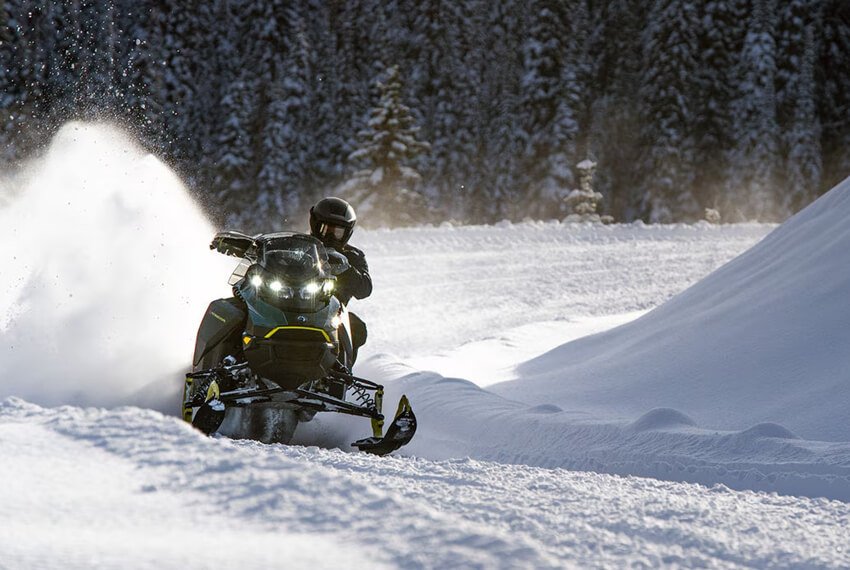
crossover snowmobile track riding
Crossover tracks (sometimes called trail/mountain tracks or all-condition tracks) are a middle-ground between trail and mountain. They are intended for riders who do both trail riding and occasional off-trail riding. These tracks balance power and floatation:
Length: Medium (often 137–146″). A common crossover length is 137″ or 146″. For example, many manufacturers offer 146×15 tracks for crossover/backcountry sleds (see Ski-Doo Backcountry or Polaris models).
Width: Typically 15″.
Lug Height: Moderate to tall (1.5″ to 2.0″). Crossover lugs are taller than pure trail tracks but not as tall as full mountain lugs. For instance, one maker’s “C35” crossover track has 1.38″ lugs and is described as grabbing traction in deep snow or on groomed trail. Another “C38” model uses 1.50″ lugs for on-trail speed with some off-trail ability. In practical terms, many crossover tracks use lug heights in the 1.6″–2.0″ range.
Drive Pitch: Often 2.86″ (on most modern sleds) or 2.52″ depending on model.
Support: Moderate – usually more support columns than a pure trail track but fewer than a mountain track.
Crossover tracks are designed for mixed conditions: groomed trails, frozen lakes, and light powder. They offer better traction in loose snow than a trail track, without the full weight penalty of a mountain track. Think of them as a compromise: good acceleration on trails plus extra bite when you wander off-trail.
Utility Tracks
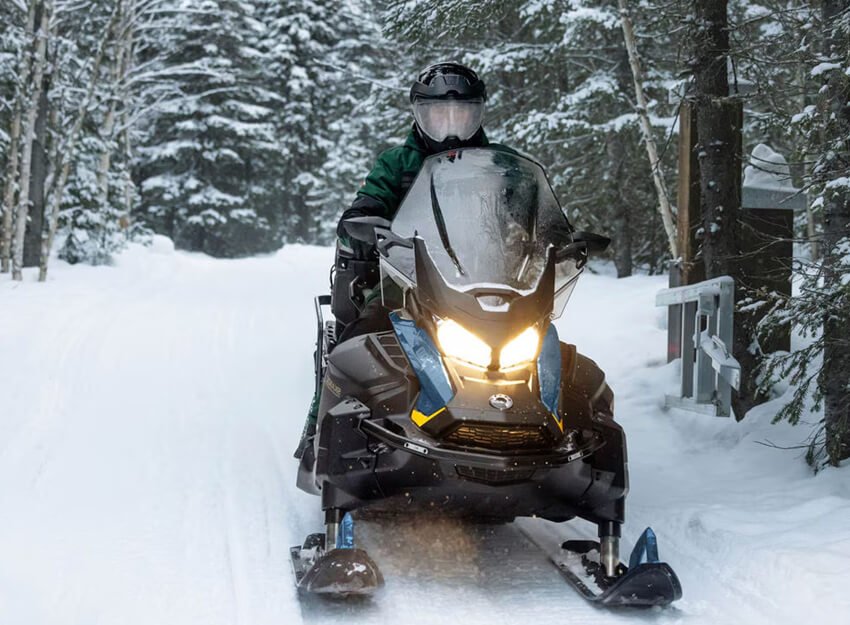
utility snowmobile track riding
Utility tracks are made for work and heavy hauling. They share some features with mountain tracks but are optimized for pulling loads and unpredictable terrain:
Length: Medium to long (often 154–156″, and sometimes as long as 162″ or more on heavy-duty models). Utility snowmobiles often use longer tracks for stability when towing or carrying.
Width: Often 15″ or 16″ (wide for flotation under heavy load).
Lug Height: Moderate (1.5″–1.8″ or more), often with cup (cupped) lugs for traction. The focus is on grip and durability, not maximum float. For example, Camso’s utility tracks use 1.5–1.8″ cup lugs to pull heavy loads.
Drive Pitch/Support: Similar to mountain tracks, with additional reinforcement (columns and stiffeners) so the track won’t fold under heavy pulls.
Clip Pattern: Fully clipped is common for maximum traction. Some utility tracks are also stud-ready or pre-studded, since these sleds often operate on ice and need good grip.
Utility tracks excel at towing, hauling, and work tasks. They provide reliable traction under load and on mixed snow/ice conditions. They are not primarily about speed or pure deep-snow flotation.
The table below summarizes these track types:
| Type | Typical Size (L×W) | Lug Height | Best For |
|---|---|---|---|
| Trail | 120–137″ × 15″ | 1.25–1.5″ | Groomed trails, speed, handling |
| Mountain | 154–175″ × 15–16″ | 2.0–3.0″+ | Deep powder, climbing |
| Crossover | 137–146″ × 15″ | 1.5–2.0″ | Mixed trail & off-trail |
| Utility | 154–156″ × 15–16″ | 1.5–1.8″ | Towing, heavy work |
(Note: These are general ranges. Always verify your sled’s allowable track size.)
How to Choose the Right Snowmobile Track
Use your main terrain as a guide:
- 🛣 Mostly Groomed Trails
→ Choose a trail track (120–137", 1.25–1.5″ lugs).
→ Prioritizes handling, efficiency, and cornering. - 🏔 Deep Snow / Backcountry
→ Go for a mountain track (154–175", 2.0–3.0″ lugs).
→ Maximizes flotation and traction in powder. - ⚖️ Mixed Riding (Trail + Off-Trail)
→ Pick a crossover track (137–146", 1.5–2.0″ lugs).
→ Balances traction off-trail with smooth trail handling. - 🛠 Work / Towing
→ Choose a utility track (154"+, 1.5–1.8″ cup lugs).
→ Built for durability and pulling power.
💡A simple rule of thumb:
The deeper the snow, the longer and taller the track should be.
The harder the trail, the shorter and lower the track should be.
Snowmobile Intercom Solutions for Better Group Talk
Reading Track Specs and Ensuring Compatibility
Incorrect track size or pitch can leave you stranded or cause damage. But generally, the process is:
- Verify stock track specs (length, width, pitch) for your model.
- Decide what lug height and track length you want based on your riding style.
- Use a fitment guide to narrow options and ensure compatibility.
- Double-check clearance and any required modifications (skid kit, spring kit) before ordering.
❌Common Beginner Mistakes to Avoid
When choosing a new track, beginners often make a few mistakes. Here are pitfalls to watch out for:
1. Picking Too-Tall Lugs for Trail Riding
A new rider might think “more lug = more traction” and choose a big mountain track for a trail sled. But on groomed trails, tall lugs just slow you down and can overload the engine.
From my experience, using taller-than-needed lugs on trails causes extra push in corners and worse fuel mileage. It can also lead to premature wear or lug failure if the lugs flex too much.
Tip: Match your lug height to your terrain. If >50% of your riding is trails, stick to 1.5″ or less.
2. Ignoring Track Clearance
Some riders fail to check if a taller/larger track will even fit their sled.
Very tall lugs might hit the heat exchanger or tunnel frame. Always check clearance or consult a dealer before getting a very tall or wide track.
Like I always say, the taller the lug height, the more you need to make sure it’ll actually clear your sled.
3. Mismatched Pitch
Always verify pitch. Buyers sometimes assume all tracks will work, but installing a 2.86″ track on a 2.52″ drive (or vice versa) won’t work without new drive sprockets.
This mistake can ruin your driveline.
4. Overlooking Fitment Guides
Beginners may not use a fitment guide or check the manual, and order a track that doesn’t fit their model.
The simplest way to avoid the wrong size is to look up the OEM track dimensions for your make/model.
Fitment guides (online or dealer) show exactly what length, width, and lug height your sled was sold with.
5. Skipping Maintenance
Once the new track is on, don’t forget to keep it in shape.
A common mistake is to assume a new track needs no care. But you should still check tension, inspect for damage, and service studs.
In short, avoid thinking “bigger is always better.” Bigger lugs and tracks have trade-offs.
Choose features that match your use case. Consult specs and experts rather than guessing.
Conclusion
Choosing the right snowmobile track means balancing your riding style, terrain, and sled setup. For beginners, start with a stock-style track and upgrade only if needed. Always check fitment and think about how often you’ll ride in each condition.
There isn't one perfect track — trail tracks work best on groomed trails, deep-snow tracks off-trail but apparently wedged on hardpack. Your decision between the good one keeps your ride safe, smooth, and enjoyable.
Top 5 Fastest Snowmobiles in The World
How to Adjust Your Snowmobile’s Track Tension
2-Stroke vs 4-Stroke Snowmobiles: Complete Comparison Guide
16 Best Gifts for Snowmobilers (Unique, Fun & Practical Options)
Snowmobile Age Requirements and Rules - Safe 101

With over 10 years of experience working on cars and trucks Item Training Supervisor Richard Reina is known around the office as one of our technical experts & real an "automobile person".
His rate of interest began, in his very own words, "at the age of two when his father educated him the distinction in between a Chevy and a Ford. Since then it's been cars regularly."
As a serious lover of practically all things with a motor Richard can address nearly any kind of inquiry related to car upkeep, fixing, or restoration & is a fact professional in electric motor background.
Motorcycle riding is all about the sense of freedom, adventure, and thrill of the open road. But come on—being connected when you ride isn't always an easy thing. Whether you're riding with a buddy, navigating traffic in the city, or long-distance riding, effective communication is crucial. That's where the Fodsports T5 and T6 come in, […]
If you're looking for a new motorcycle intercom system this year, Fodsports has something exciting in store. The company has launched two new Bluetooth helmet intercoms: T1 and T1 Pro. Both models bring upgraded features, sleek design, and high-definition audio quality for riders who want to stay connected, entertained, and safe on the road. But […]
Fodsports T1 and T1 Pro: The Newest Bluetooth Intercoms for Riders. Whether you’re cruising on highways, exploring rugged trails, or commuting daily, clear communication is key. Fodsports is thrilled to launch its latest Bluetooth intercoms: the T1 and T1 Pro. Built for riders who demand reliability, versatility, and crystal-clear sound, these devices redefine how you […]
Many riders who aren't so tall or ladies just starting to ride bikes need to pick out the best Motorcycles for Short Riders and Women. They gotta look for three key things: a seat that's not too high up, a bike that's not too heavy, and something that looks good enough to give them confidence. […]
Fodsports FX 60C vs FX30C Pro: What's new techs are the FX 60C bringing to us? Fodsports is a brand worth-mention for helmet communication and video recording. This brand has established itself as a key player with its innovative Bluetooth camera intercom systems. Recently, Fodsports has released a new camera intercom, the FX 60C. How […]
